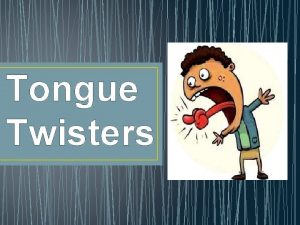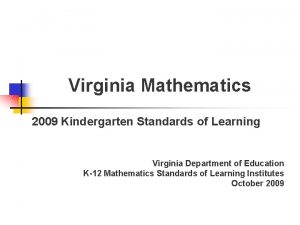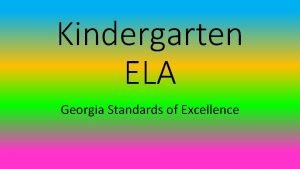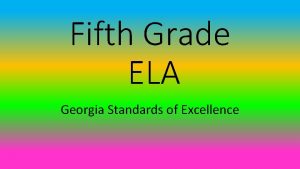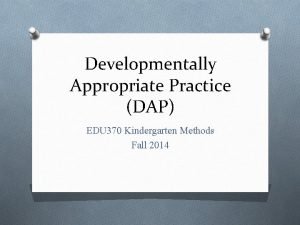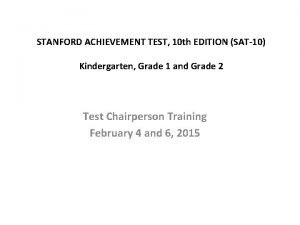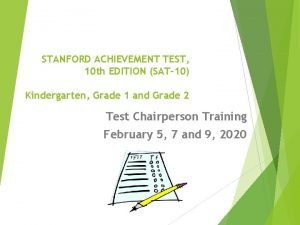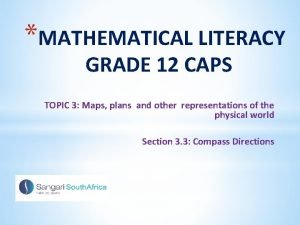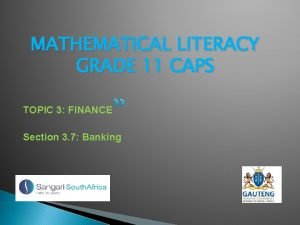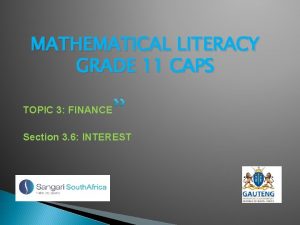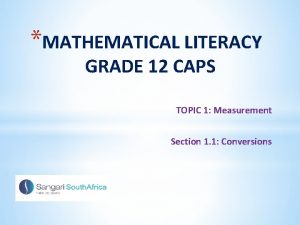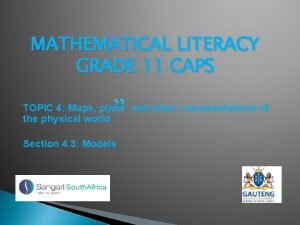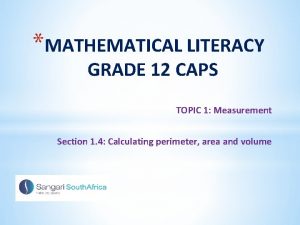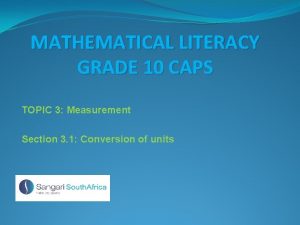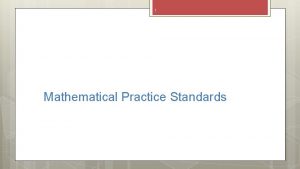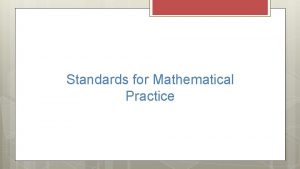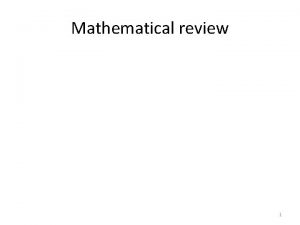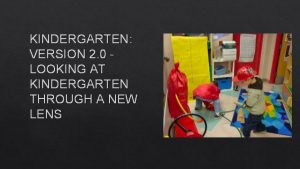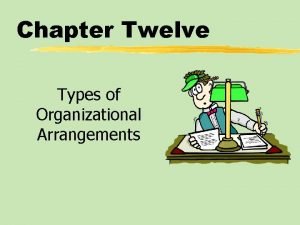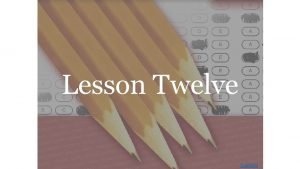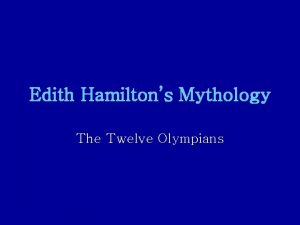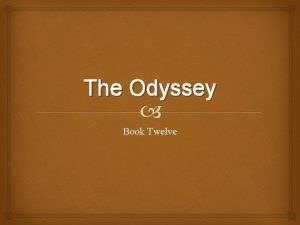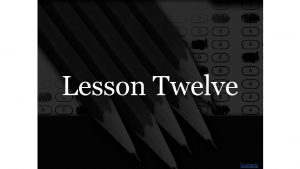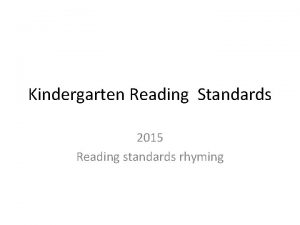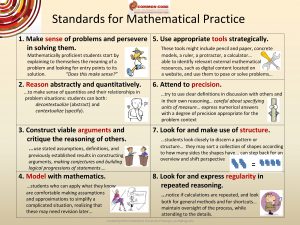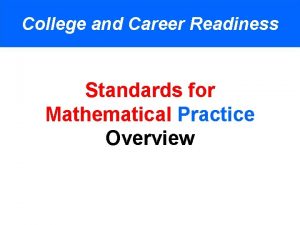Kindergarten through Grade Twelve Standards for Mathematical Practice









































- Slides: 41

Kindergarten through Grade Twelve Standards for Mathematical Practice Unit 4: Modeling and Using Tools (MP 4 and MP 5) CALIFORNIA DEPARTMENT OF EDUCATION Tom Torlakson, State Superintendent of Public Instruction

2 | California Department of Education

Unit 4 Learning Objectives • You will be able to describe why, to be successful in mathematics, all students need to model and use tools. • You will be able to explain what it means for students to model with mathematics. • You will be able to explain what it means for students to use appropriate tools strategically. 3 | California Department of Education

Unit 4 Overview • Unpacking MP 4 and MP 5 • Modeling with Mathematics • Examples of Modeling at the Grade Level Spans • Use Appropriate Tools • Using Tools at the Grade Level Spans • Summary and Reflections 4 | California Department of Education

4. 0 Unpacking MP 4 and MP 5 Read MP 4 and MP 5 • Highlight key words or phrases that seem particularly cogent to you or that puzzle or intrigue you. • Make a note of questions you have about particular parts of these two mathematical practices. • Consider in particular how the two practices are related. 5 | California Department of Education

Small Group Discussion • • • What key words or phrases did you highlight and why they were important to you? What questions do you have about these two mathematical practices? In what ways do you allow your students to model with mathematics? What tools do you use to help students make sense of the mathematics they are learning? What are some questions you hope will be answered in this unit? Consider the practices you currently use and the challenges you might anticipate. 6 | California Department of Education

4. 1 Introduction to Modeling with Mathematics (MP 4) • “Modeling” is mathematizing a situation (e. g. , structuralizing, idealizing, and making assumptions) or making use of a given or constructed model by interpreting or validating it in relation to context. • Modeling is important because it links classroom mathematics and statistics to everyday life. 7 | California Department of Education

The Program for International Student Assessment (PISA) Rubric Continuum of Modeling Problems: • Level 0: Purely computational or context is unnecessary for solving • Level 1: Directly translatable from a context (e. g. , a simple word problem from which students can formulate an equation). • Level 2: A model can be modified to satisfy changed conditions. Allow students to study patterns and relationship between quantities, and represent these patterns and relationships using words, numbers, symbols, and pictures. May have multiple solution strategies, but usually one correct solution. • Level 3: Have no predetermined solution. Require students to make assumptions about the context, develop strategies to solve them, check answers, present results, and possibly revise solution strategies and begin the process over again. 8 | California Department of Education

The Program for International Student Assessment (PISA) Rubric 9 | California Department of Education

An Example of Modeling with Mathematics Tat Ming is designing square swimming pools. Each pool has a square center that is the area of the water. Tat Ming uses blue tiles to represent the water. Around each pool there is a border of white tiles. Below are pictures of the three smallest pools that he can design with the blue tiles for the interior and white tiles for the border (Ferrini-Mundy, et al. , 1997). 10 | California Department of Education

Tiling Pool Problem • Complete the “Tiling Pool Problem” at your grade level span. • Discuss the mathematics that emerge with other members of your grade span group. 11 | California Department of Education

Meeting the Needs of All Learners • The resources and strategies below help to make the Tiling Pool Problem accessible to all learners. The supports provide options for motor skills, visual, auditory, and language flexibility: – The illustrations of the pools and pictures of the backyard help students visualize the problem. – The grid paper allows students to draw pictures of the pools, whereas tiles permit students to construct the pools to aid in understanding. • When students work in groups to problem solve they are provided with an opportunity to engage in discourse about mathematics. 12 | California Department of Education

4. 1 Summary • Modeling is mathematizing a situation, or making use of a model by interpreting it in relation to the context. • Modeling is important because it links mathematics to everyday life. • Modeling with mathematics exists along a continuum; – from problems that are directly translatable from a context, – to problems that have no predetermined solutions 13 | California Department of Education and require students to make assumptions,

Reflection In grade span groups, discuss: • How the pool-tiling task allows students to analyze relationships mathematically in order to draw conclusions. • The ways the task allows students to think creatively and work with others. • How you would adapt this lesson for English learners and/or students with special needs in your classroom. 14 | California Department of Education

4. 2 Modeling with Mathematics at Different Grade Level Spans What does modeling with mathematics look like in the different grade level spans? • Review sample problems by grade level span. • Note similarities and differences in modeling. • Consider how problems in the early grades support the level of complexity of 15 | California Department of Education

Modeling at Different Grade Spans • Early grades: Students might choose to use manipulatives, such as linking cubes, to help them solve an addition or subtraction problem in context. They may also write an equation to describe a situation. • Middle grades: Students learn habits and skills that are central to the development of higher-level mathematical thinking. • High school: Students use modeling as a process of choosing appropriate mathematics and statistics 16 | California Department of Education

Quotes on Modeling • Refer to “Quotes on Modeling” (Handout 4. 2. 1). • With a partner, read and discuss the quote that represents your grade level span. 17 | California Department of Education

Examples of Modeling Activities • Refer to the “Examples of Modeling Activities” handout that represents your grade level span (Handouts 4. 2. 2 – 4. 2. 4). • Review the problems, noting the level of each as defined on the PISA rubric. • Complete the problems and compare solutions and strategies. • Discuss how the difference in the subtle wording of the problems change the difficulty level. 18 | California Department of Education

Students Making Sense of a Problem • View middle school students engaging in a problem that requires modeling. • Consider the following questions as you watch: – How did students apply the mathematics they knew to solve the problem? – How comfortable did students appear to be in making assumptions and approximations to simplify the problem? – How did the students interpret their results in the context of the problem? Video available on the Brokers of Expertise Web site: 19 http: //myboe. org/portal/default/Content/Viewer/Content? action=2&sc. Id=306591 | California Department of Education

Video Reflection Discuss in small groups: • How did the students make sense of the problem and how did they made adjustments to their models? • How might you bring this type of problem into your classroom? 20 | California Department of Education

Reflection on Mathematical Modeling In your Metacognitive Journal, write about how modeling with mathematics allows students to reason effectively. • How does modeling with mathematics help students to make judgments and decisions? • In what ways does modeling with mathematics help students to solve different types of problems in conventional and innovative ways? • How would you make modeling with mathematics accessible to English learners and/or students with special needs in your 21 | California Department of Education

4. 3 Introduction to Using Appropriate Tools Strategically (MP 5) When modeling with mathematics, the use of appropriate tools is essential for students to acquire the most out of a mathematical task. • Tools are any object, picture, drawing, or figure that represents a mathematical concept used by students to make meaning of the mathematics, or on which the relationship for that mathematical concept can be imposed (Van De Walle, 2004). • Tools allow students to interactively reason and engage in discourse about mathematics, helping 22 | California Department of Education them to construct mathematical meanings and

Discussion Discuss in grade span groups: • What are some of the appropriate tools needed for the Tiling Pool Problem for students in your grade span? • How will each tool help promote student mathematical understanding? 23 | California Department of Education

Tools for Each Grade Span 24 | California Department of Education

Grades K– 2 Tools Partial list of tools that might be used in early grades : color tiles computer student use of interactive technology (e. g. , SMART boards, tablets) drawing paper large square grid paper colored pencils base ten blocks 25 | California Department of Education two-colored counters cubes pattern blocks multi-link cubes rods geoboards personal white boards counting bears rulers

Grades 3– 5 Tools Partial list of tools that could be used in grades 3– 5: color tiles rods computer Interactive technology (e. g. SMART boards, tablets) drawing paper large square grid paper colored pencils base ten blocks two-colored counters pattern blocks 26 | California Department of Education geoboards protractors compasses rulers non-scientific calculator personal white boards algebra tiles centimeter cubes multi-link cubes

Grades 6– 8 and 9– 12 Tools Partial list of tools that might be used in secondary grades: graph paper tiles colored pencils interactive technology (e. g. , SMART boards, tablets) handheld technology base ten blocks two-colored counters cubes pattern blocks 27 | California Department of Education multi-link cubes rods geoboards protractors compasses rulers personal white boards algebra tiles computers centimeter cubes

Differentiating Instruction Through the Use of Technology and Tools • The National Council of Teachers of Mathematics (NCTM) encourages the use of technology as a tool to support and extend mathematical reasoning and sense making, gain access to mathematical content and problem-solving contexts, and enhance computational fluency (NCTM, 2000). • Carefully selected technology tools have the potential to provide multiple opportunities for differentiated instruction 28 | California Department of Education

Differentiating Instruction Through the Use of Technology and Tools Well-chosen technology and activities can support and enable students of all levels of procedural fluency to engage in higher cognitive activities such as modeling, conjecturing, looking for structure, and repeated reasoning. 29 | California Department of Education

Differentiating Instruction Using Technology and Tools: Video Carefully selected and focused online tools offer an engaging option for differentiated learning. • Elementary Example: How computer games can help young students master key mathematical concepts. https: //www. teachingchannel. org/videos/differentiating-in-math? resume=0 • Secondary Example: How technology allows older students to explore, make conjectures, and see structure. 30 | California Department of Education

Summary MP 5 (using appropriate tools strategically) incorporates a wide range of mathematical “tools” to enhance student engagement, discourse, reasoning, and expression for sense making of key mathematical concepts. Discuss: How do you use tools for the purposes listed above? 31 | California Department of Education

Reflection • In your Metacognitive Journal, provide an example of how using tools might allow your students to articulate their ideas effectively. • Consider a variety of forms and contexts. 32 | California Department of Education

4. 4 Use of Tools at Different Grade Level Spans The use of tools is important at all grade level spans, but the types of tools and how they are used can differ depending on grade level. Discuss: • What tools are universal for all grade levels and what tools differ by grade level spans? • What characterizes the difference in the appropriateness of a tool at a particular 33 | California Department of Education

Examples of Using Tools Tasks • Refer to the “Using Tools” tasks that represent your grade level span (Handouts 4. 4. 1 – 4. 4. 3). • Review the problems. • Discuss: – What concepts are reinforced? – How do the tools help students make sense of the context of the problem? – How could you modify the task(s) to meet the needs of all students? 34 | California Department of Education

Using Tools Strategically: Video Examples • The following video examples demonstrate the appropriate and strategic use of tools. • As you view the video(s), take note of how students use tools to solve problems that are posed. Elementary Example: https: //www. teachingchannel. org/videos/teaching-fractions Secondary Example: https: //www. teachingchannel. org/videos/teaching-subtracting-integers 35 | California Department of Education

Video Reflection In the videos, students used two-color counters and pattern blocks as tools to make sense of the problems they were trying to solve. Discuss: • What you observed; particularly how students used tools to solve the problems. • How these tools helped students explore and deepen their understanding of mathematical concepts. 36 | California Department of Education

Written Reflection In your Metacognitive Journal, explain how using tools allows students to demonstrate their ability to work effectively and respectfully with diverse teams. • How does using tools help students to exercise flexibility and make compromises to accomplish a common goal? • How does using tools help students assume shared responsibility for collaborative work and value the individual contributions made by each team member? • In terms of the physical location of tools and student 37 | California Department of Education choice, how would you make the use of tools

4. 4 Summary • There are tasks at all grade levels where tools are an important part of the problem solving process, whether the task is a modeling problem or computational in context. • Sometimes it is clear what the tool should be for a task, and sometimes students can make choices about the tools that will work best for them. • Providing students with a choice of tools differentiates for the variety of learners in the classroom, including English learners and students with special needs. 38 | California Department of Education

Unit Summary and Reflection • In this unit, you have considered the Modeling and Using Tools practices; MP 4 and MP 5. – Modeling with mathematics requires students to make assumptions and approximations to simplify a situation, realizing these may need revision later. – Modeling with mathematics requires students to interpret mathematical results in the context of the situation and reflect on whether they make sense. – Using tools strategically requires that students are familiar with appropriate tools to decide when each tool is helpful; knowing both the benefits and limitations. – Using tools strategically requires students to detect possible errors, identify relevant external mathematical resources, and use them to pose or solve problems. 39 | California Department of Education

Unit Reflection Think about your understanding of these two practices and how they work together. Refer to the four PISA modeling levels and respond to the following questions: – For your grade level, describe a task for each of the three levels of modeling. Provide justification for why the task fits that particular level. – Name three tools that you currently have access to in your classroom and describe a task for which each tool would be appropriate. – Students need to know the procedures for using manipulatives to learn mathematics. Create a plan to reach this goal in your classroom. – Although the use of calculators is often debated, describe 40 | California Department of Education

California’s Common Core State Standards for Mathematics
 Tongue twisters funny
Tongue twisters funny Mathematical vs non mathematical economics
Mathematical vs non mathematical economics Virginia kindergarten standards
Virginia kindergarten standards Georgia kindergarten ela standards
Georgia kindergarten ela standards Georgia kindergarten reading standards
Georgia kindergarten reading standards Sat 10 practice test kindergarten
Sat 10 practice test kindergarten Developmentally appropriate practice for kindergarten
Developmentally appropriate practice for kindergarten Stanford achievement test kindergarten
Stanford achievement test kindergarten Stanford 10 test
Stanford 10 test Types of maps in maths lit grade 12
Types of maps in maths lit grade 12 Maps and plans
Maps and plans Mathematical literacy maps and plans
Mathematical literacy maps and plans Finance mathematical literacy grade 12
Finance mathematical literacy grade 12 Grade 11 mathematical literacy finance questions
Grade 11 mathematical literacy finance questions Tariff calculation formula
Tariff calculation formula Mathematical literacy grade 10 measurements
Mathematical literacy grade 10 measurements Conversions maths literacy grade 12
Conversions maths literacy grade 12 Maths literacy grade 12 packaging
Maths literacy grade 12 packaging Exchange rate meaning in maths literacy
Exchange rate meaning in maths literacy Measurement maths literacy grade 12
Measurement maths literacy grade 12 Mathematical literacy grade 10 measurements
Mathematical literacy grade 10 measurements Mathematical literacy grade 10 measurements
Mathematical literacy grade 10 measurements Maps, plans and other representations of the physical world
Maps, plans and other representations of the physical world Factors necessary for appropriate service standards
Factors necessary for appropriate service standards Through one man sin entered the world, and through one man
Through one man sin entered the world, and through one man Classes of furcation
Classes of furcation Disadvantages of timber conversion
Disadvantages of timber conversion Night of the scorpion written by
Night of the scorpion written by Kontinuitetshantering i praktiken
Kontinuitetshantering i praktiken Novell typiska drag
Novell typiska drag Nationell inriktning för artificiell intelligens
Nationell inriktning för artificiell intelligens Ekologiskt fotavtryck
Ekologiskt fotavtryck Varför kallas perioden 1918-1939 för mellankrigstiden
Varför kallas perioden 1918-1939 för mellankrigstiden En lathund för arbete med kontinuitetshantering
En lathund för arbete med kontinuitetshantering Kassaregister ideell förening
Kassaregister ideell förening Tidbok yrkesförare
Tidbok yrkesförare A gastrica
A gastrica Densitet vatten
Densitet vatten Datorkunskap för nybörjare
Datorkunskap för nybörjare Boverket ka
Boverket ka Tes debattartikel
Tes debattartikel Delegerande ledarskap
Delegerande ledarskap
